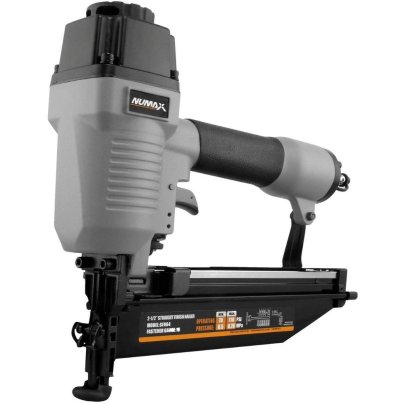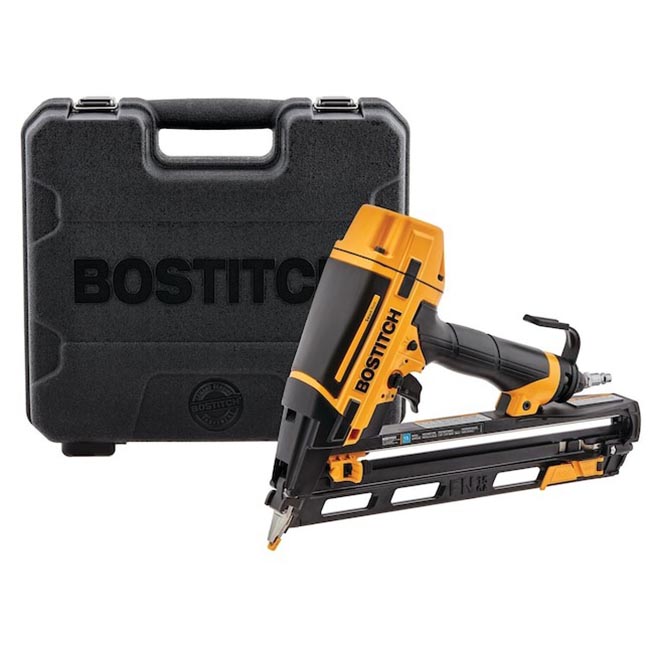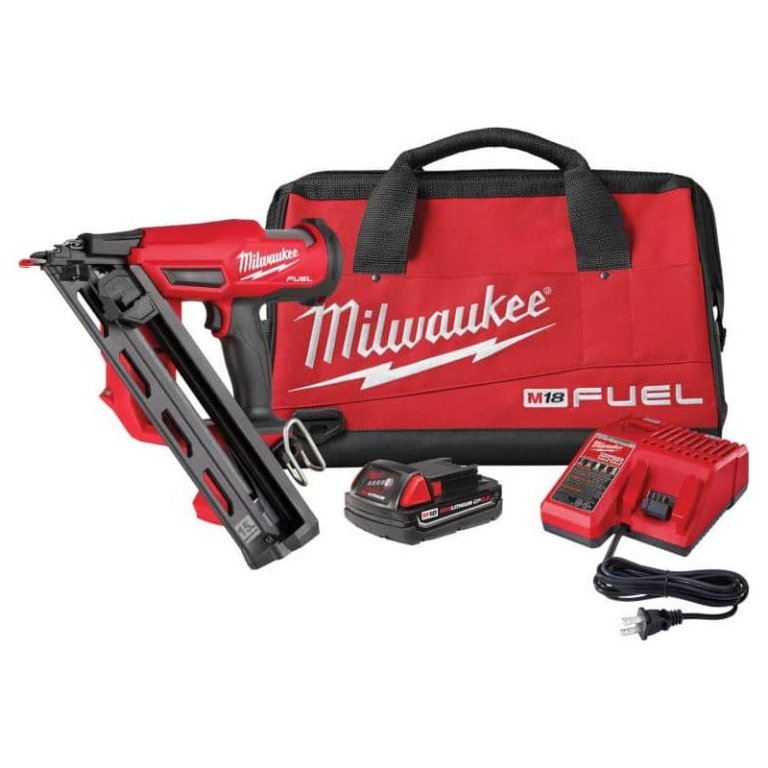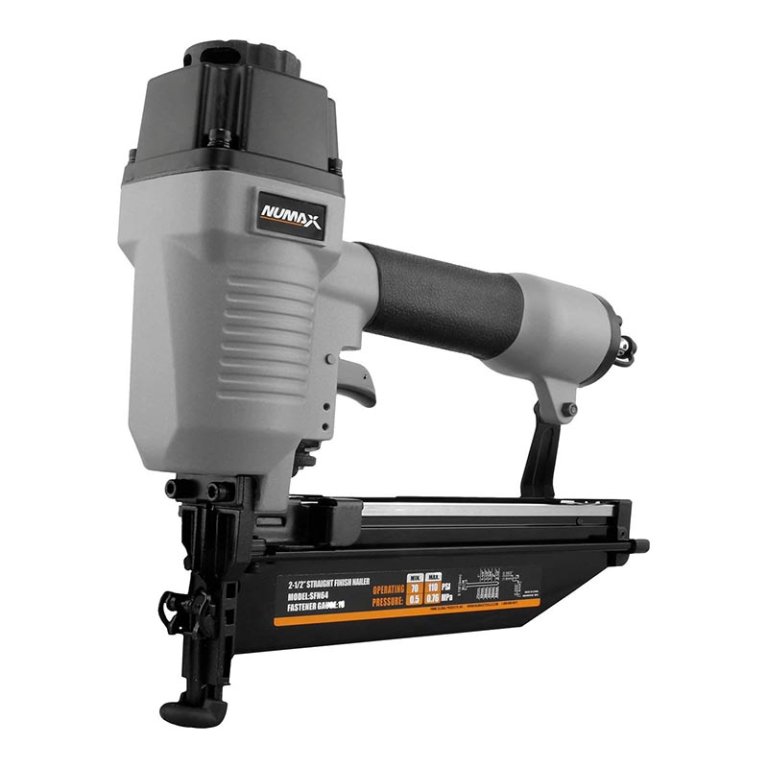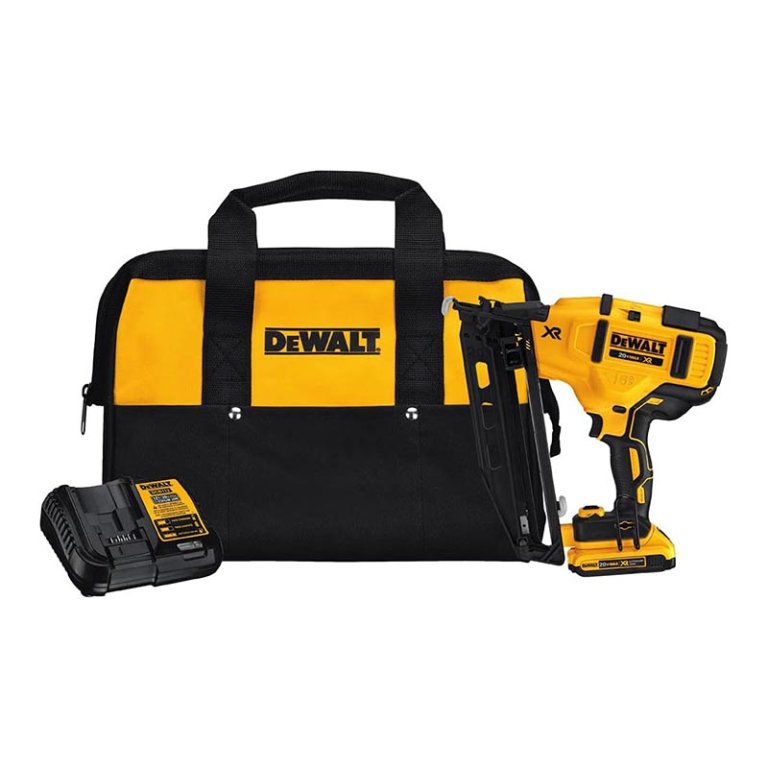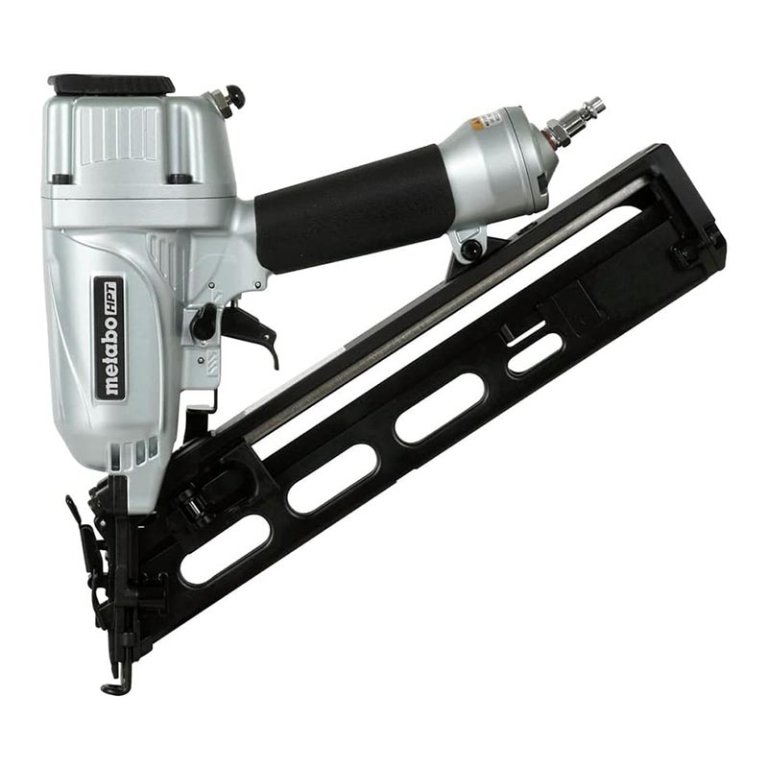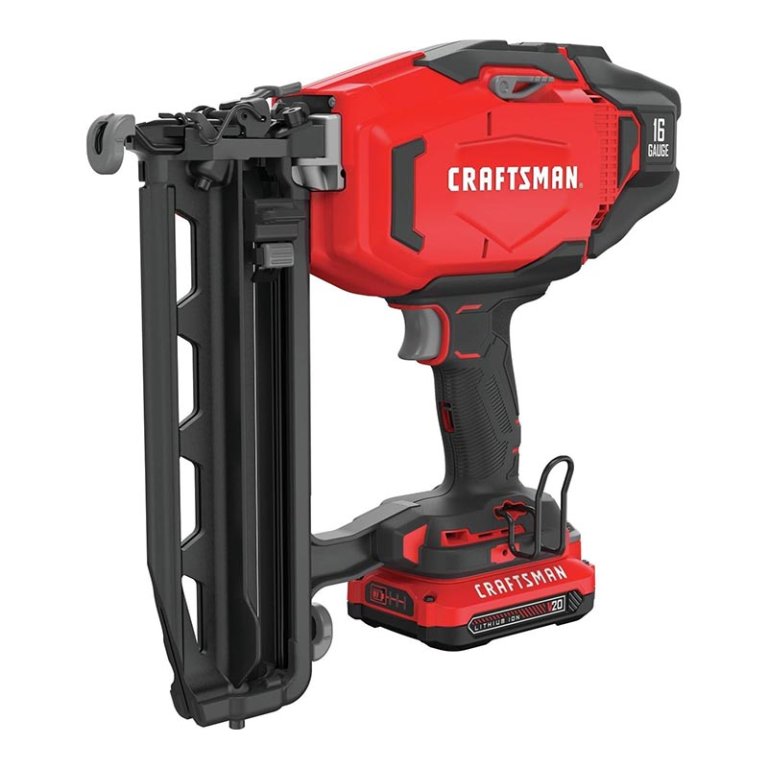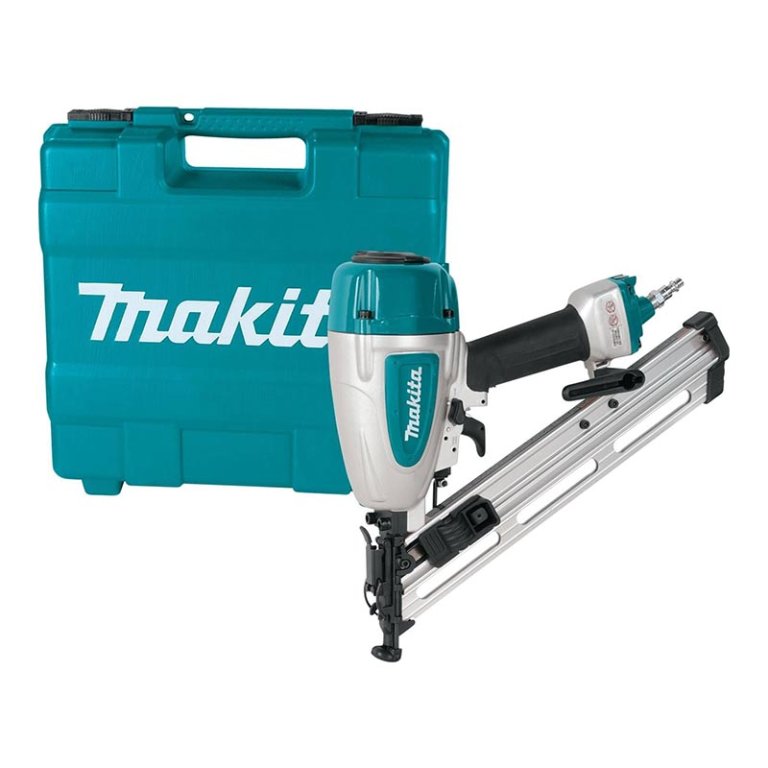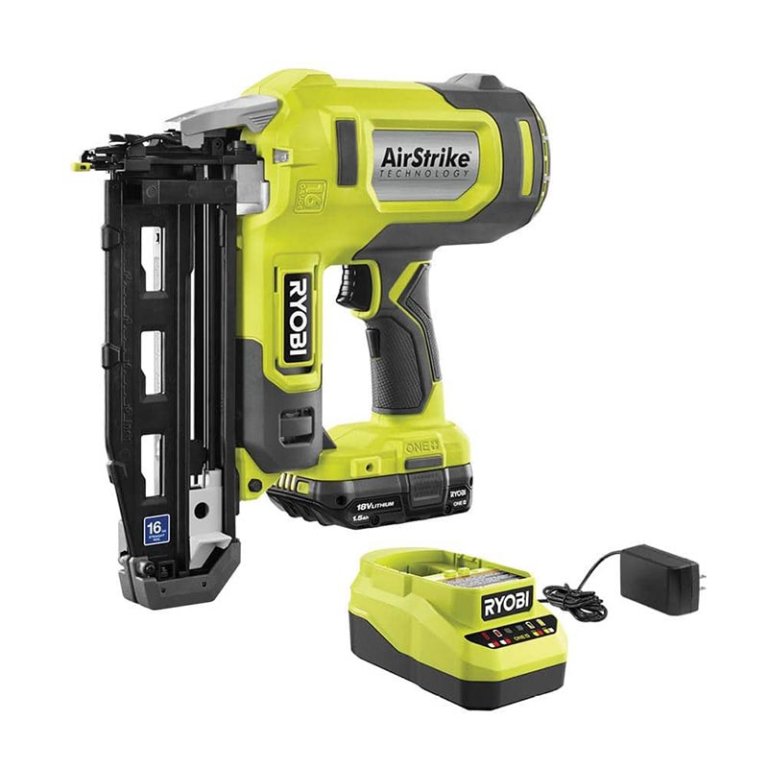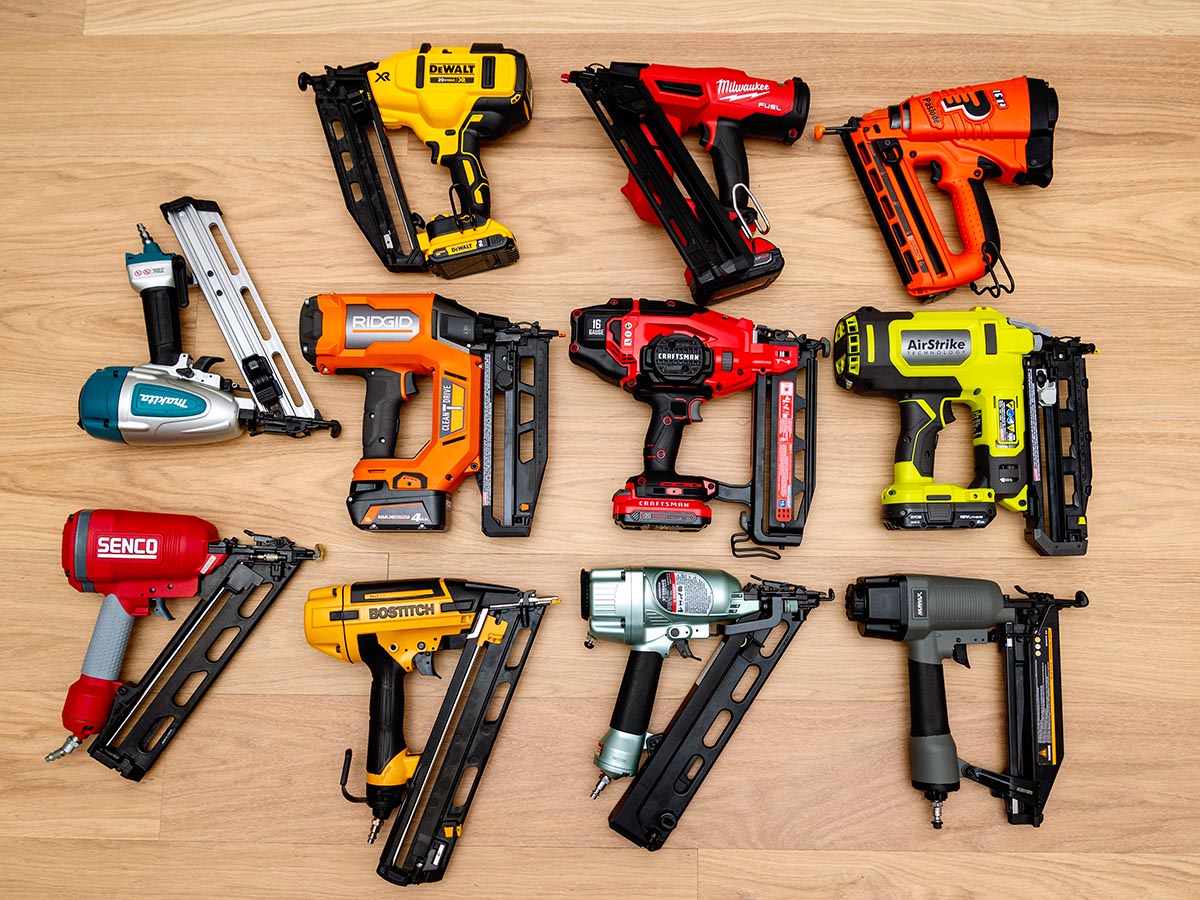
We may earn revenue from the products available on this page and participate in affiliate programs. Learn More ›
Few power tools can save time like a finish nailer. These handy tools replace the tedious task of driving thin finishing nails into finished carpentry, which would require one to painstakingly hammer the nails using a nail set to avoid damaging the wood. Instead, finishing nailers make the process of installing molding and trim or building cabinetry much faster and easier.
A finish nailer usually consists of a magazine that holds 100 or more finishing nails; inside the gun is a mechanism that fires a piston, which propels the nail into the wood. These guns may be powered by gas, electricity, or compressed air. The best finishing nailers can drive 15-gauge nails measuring up to 2.5 inches long into the hardest woods.
After researching many 15-gauge and 16-gauge finishing nailers, we tested some of the best models on the market, including popular pro-grade models and affordable DIYer-friendly options. We detailed our observations in the reviews ahead. If you’re trying to pin down the best finish nailer, keep reading to learn more about which features we suggest considering while you shop.
- BEST OVERALL: Bostitch Smart Point 15 GA Angled Finish Nailer Kit
- RUNNER-UP: Milwaukee M18 Fuel 15 GA Finish Nailer Kit
- BEST BANG FOR THE BUCK: NuMax Pneumatic 16 GA 2½-Inch Straight Finish Nailer
- BEST 16-GAUGE: DeWalt 20V MAX XR 16 GA Cordless Angled Finish Nailer
- BEST 15-GAUGE: Metabo HPT 2½-Inch 15 GA Angled Finish Nailer Kit
- BEST PNEUMATIC: Senco FinishPro 42XP Finish Nailer
- BEST ELECTRIC: Craftsman V20 Cordless 16 GA Finish Nailer Kit
- BEST GAS: Paslode Cordless 16 GA Angled Finish Nailer
- BEST ANGLED: Makita 15 GA 2½-Inch 34-Degree Angled Finish Nailer
- BEST STRAIGHT: Ryobi ONE+ 18V AirStrike 16 GA Finish Nailer Kit
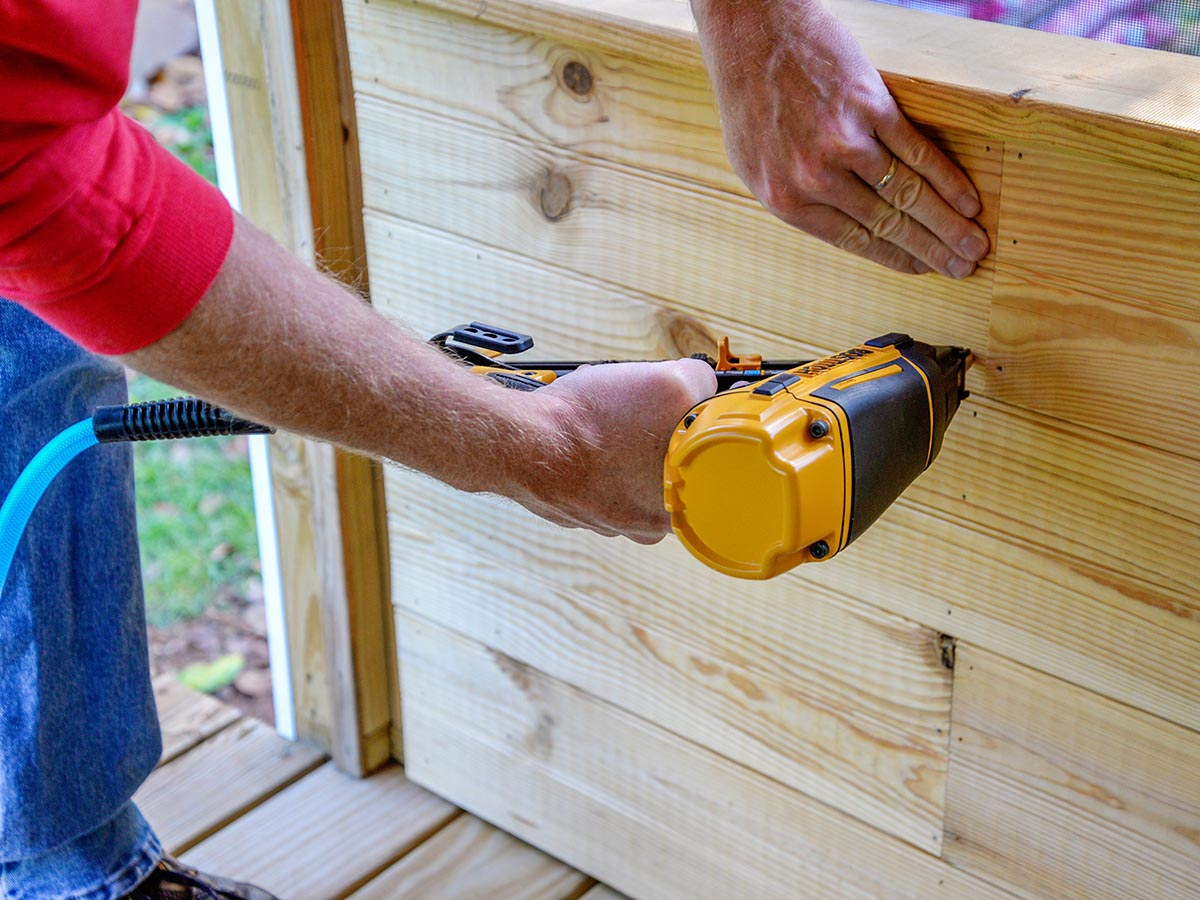
How We Tested the Best Finish Nailers
We performed side-by-side performance tests to compare and contrast the 10 nailers in this guide. First, we loaded each nailer with a full cartridge of either 1.25-inch nails (for 16-gauge nailers) or 1.5-inch nails (for 15-gauge nailers). We discharged them along straight lines drawn on hardwood and softwood boards to test speed and accuracy in both contact and sequential firing modes. We repeated the test with thicker boards and 2.5-inch nails.
After driving 200 nails with each test model, we evaluated them in terms of maneuverability and operator comfort, firing speed and accuracy, ease of loading, resistance to jamming, and noise. We then used prompts from a scoring rubric to calculate our ratings and give each product an appropriate award.
Testing Stats
- Products tested: 10
- Hours spent testing: 8
- Tests performed: 6
- Average price: $242.08
Our Top Picks
Our favorite finishing nailers are capable of driving nails up to 2.5 inches long, and they boast the power, speed, and precision to complete projects quickly. We tested each of the products we included in this list, which includes 15-gauge and 16-gauge pneumatic and cordless nail guns from some of the best-known names in power tools. Check out the reviews to find out what we liked about them, which could help you decide if one may be right for you.
Best Overall
Bostitch Smart Point 15 GA Angled Finish Nailer Kit
What We Like
- Cordless, pneumatic, and lightweight, this air nailer minimizes user fatigue and eliminates the need to charge batteries
- Angled nailer easily and accurately reaches inside corners and other difficult locations
- Nonmarring tip protects workpieces from accidental scuffs and dents
- Choose from sequential (more precise) and contact/bump (faster) firing modes
- More durable and less expensive than a cordless finish nailer
What We Don’t Like
- Requires an air compressor and hose, which may be less convenient for some projects
- Uses 25-degree angled nails, which are less common than 34-degree angled nails
Product Specs
- Type: Pneumatic
- Gauge: 15
- Weight: 4 pounds 8.5 ounces
- Nail depth: 1.25 to 2.5 inches
Our Ratings: Ease of Use 4.3/5; Performance 5/5; Quality 4.3/5; Value 4.5/5
There’s no need to invest money and storage space in several specialized tools when one well-designed, all-purpose option can get the job done. If you’re looking for a great finishing nailer that can tackle a wide range of projects, Bostitch’s angled finish nailer has you covered. This lightweight and maneuverable nailer features a 25-degree angled magazine for excellent reach into tight spaces. It also features a narrow point that provides excellent visibility, making it easier to place your fasteners precisely where you mean to.
Some of the pro-quality highlights built into this tool include a tool-free jam release mechanism, a dial-a-depth adjustment knob, a selectable trigger to switch between sequential and bump nailing, and an integrated air blower to keep the work surface clean. It also offers numerous convenience features, such as a 16-inch on-center gauge, a belt hook with an integrated pencil sharpener, and oil-free operation.
We chose a pneumatic nailer as our top pick because of its low cost and high reliability compared to battery-powered nailers. The Bostitch finish nailer stood out among our test group as one of the most comfortable and easy to use. During our 1,000-nail test, it consistently fired accurately without jamming. We were able to run it completely empty, and it drove the last nail as accurately as the first. Unlike several of the other air nailers we tested, it does not require oiling, and it offers both contact and sequential nailing at the flip of a switch.
Get the Bostitch finish nailer at Lowe’s or Amazon.
Runner-up
Milwaukee M18 Fuel 15 GA Finish Nailer Kit
What We Like
- Powered by an 18 volt (V) 2 amp hour (Ah) battery; drives up to 750 nails per charge
- The fastest, most powerful, most jam-resistant cordless finish nailer we tested
- 34-degree angled nailer easily reaches tight corners that straight nailers cannot
- No ramp-up time, allowing for faster sequential firing and bump nailing
What We Don’t Like
- Weighs more than 7.5 pounds; heaviest of all the nail guns we tested
- Highest price among all finish nailers in the test group
Product Specs
- Type: Battery
- Gauge: 15
- Weight: 7 pounds 8.4 ounces
- Nail depth: 1.25 to 2.5 inches
Our Ratings: Ease of Use 4/5; Performance 4.5/5; Quality 4.5/5; Value 4.5/5
Cordless finish nailers often operate at a power disadvantage compared to their pneumatic counterparts, but that’s not the case with the Milwaukee M18 finish nailer. As the only battery-powered 15-gauge nailer in our test group, this tool delivered an impressive performance on par with the air-powered nailers.
An 18V battery powers this cordless finishing nail gun. It boasts a 34-degree angled magazine, so it can easily reach into tight corners. And with the option of firing in either sequential or contact mode, it can fire up to 750 nails per charge (and up to 3 nails per second) with zero ramp-up time. It proved to be the strongest, fastest, and most worry-free of all the cordless finishing nailers in our test.
Although it was the heaviest and most expensive nailer among our test group, the Milwaukee M18 nailer scored top marks in terms of cordless maneuverability and nailing performance. Without fussing around with an air hose and compressor, it was easy to move from room to room or go outside and start nailing. In our 1,000-nail test, it became jammed once, but we were able to easily clear the jam and keep going. And despite its impressive power, the noise was not bad—quieter than you might expect.
Read our full review: Milwaukee M18 Fuel 15 GA Finish Nailer Kit
Get the Milwaukee finish nailer at The Home Depot, Amazon (tool only), US Tool and Fastener, or Nail Gun Depot.
Best Bang for the Buck
NuMax Pneumatic 16 GA 2½-Inch Straight Finish Nailer
What We Like
- Lowest price of all the finish nailers in our test group at time of writing
- Lightweight build and ergonomic grip for comfortable extended use
- Drives nails as short as 1 inch, which is beneficial while working with thin material
What We Don’t Like
- Top-loading nails into the magazine is unnecessarily awkward
- This was the only pneumatic nailer that jammed during testing, although clearing the jam was not difficult
Product Specs
- Type: Pneumatic
- Gauge: 16
- Weight: 4 pounds 1.5 ounces
- Nail depth: 1 to 2.5 inches
Our Ratings: Ease of Use 3.7/5; Performance 4.5/5; Quality 4.3/5; Value 4.5/5
Nailers can be one of the pricier power tools a shopper can buy, which is why this pneumatic nail gun from NuMax is such a great option. Priced well below the average cost of most air nailers, it’s an affordable and effective tool for budget-conscious woodworkers.
With its straight magazine, the NuMax 16-gauge pneumatic nail gun is capable of firing finish nails from 1 to 2.5 inches long. An adjuster dial makes setting the proper nail depth quick and easy. With its soft, rubberized grip and light 4.09-pound weight, this nail gun is easy to operate and maneuver. Like pricier competitors, it comes equipped with nonmarring tips, tool-free depth adjustment, and a quick-jam-release mechanism. The lightweight body and contoured rubber grip make it comfortable for extended use.
We liked almost everything about the NuMax nailer. The price was excellent, it felt great in the hand, and it only jammed four times during our 1,000-nail test. Clearing the jams was fast and easy. The small tool body provided clear visibility of the point for precise nail placement. However, we didn’t love the top-loading magazine—the process was awkward, especially because the nails didn’t go in easily. This was the only model that didn’t load from the rear.
Get the NuMax finish nailer at Amazon, Lowe’s, or The Home Depot.
Best 16-Gauge
DeWalt 20V MAX XR 16 GA Cordless Angled Finish Nailer
What We Like
- Outstanding combination of performance and affordability
- Cordless convenience with the maneuverability of a 20-degree angled nailer
- One of the lightest cordless nailers we tested; great for extended use
- LED lights illuminate the work surface, improving placement accuracy
What We Don’t Like
- Approximate 1-second ramp-up time between nails in sequential mode
Product Specs
- Type: Cordless electric
- Gauge: 16
- Weight: 6 pounds 4.6 ounces
- Nail depth: 1.25 to 2.5 inches
This Bob Vila Approved product carries our brand’s highest level of recommendation.

Bob Vila Approved recognizes the household and DIY products that impressed us most in our real-world testing and that exemplify core values of the Bob Vila brand, including craftsmanship, innovation, and value for the dollar. Winners of this designation come recommended by our professional review team and are personally approved by Bob Vila.
Our Ratings: Ease of Use 4.7/5; Performance 4/5; Quality 4/5; Value 5/5
This battery-powered 16-gauge finish nailer from DeWalt delivers power and convenience at a value price. Although many battery-operated nailers are heavy, DeWalt utilizes a compact 20V battery to keep this nailer’s weight at just a tad over 6 pounds, putting it in the same weight class as some pneumatic finish nail guns. This makes it an excellent portable finish nailer.
The DeWalt nailer has a magazine capacity of 110 nails and can drive nails up to 2.5 inches long. It offers the choice of either sequential or bump operating mode for rapid nailing, and it uses a 20-degree angle for getting into smaller spaces. It also comes equipped with a work surface light for better visibility. The LED lights flash to let the user know when the battery is getting low. A soft, rubberized grip adds comfort during bigger jobs.
This was our favorite of all the 16-gauge nail guns. It produced better-than-average nailing power, and it worked reliably without jamming once during the 1,000-nail test. Due to its split-second ramp-up time between nails, it was not the fastest battery-powered finishing nailer, but it did a great job overall. The depth adjustment and sequential/contact firing selector both worked smoothly. We also liked the in-line magazine configuration when it came to precise nail placement, as opposed to an offset magazine.
Get the DeWalt finish nailer at Amazon, Ace Hardware, or The Home Depot.
Best 15-Gauge
Metabo HPT 2½-Inch 15 GA Angled Finish Nailer Kit
What We Like
- Provides strong nailing power with minimal user fatigue thanks to its light weight
- Easy-to-use depth adjustment dial for flush nailing or countersinking in different materials
- Integrated duster keeps work surface clean for improved nailing accuracy
- 34-degree angled nailer can easily access hard-to-reach spots like inside corners
What We Don’t Like
- Requires an air hose and compressor (not included)
- The nail cartridge pusher sometimes fails to fully seat nails under the driver
Product Specs
- Type: Pneumatic
- Gauge: 15
- Weight: 4 pounds 5 ounces
- Nail depth: 1.25 to 2.5 inches
Our Ratings: Ease of Use 4.7/5; Performance 4.5/5; Quality 4.3/5; Value 4.5/5
This pneumatic finish nailer from Metabo HPT, formerly Hitachi Power Tools, offers unprecedented power coupled with some excellent user features. With the force of compressed air behind it, this nailer fires heavier 15-gauge nails, which create sturdier connections than their smaller 16-gauge counterparts. A convenient switch allows the user to toggle between single shots and rapid-contact nailing when they want to speed up the job. A depth dial allows for quick changes to nail-depth settings. It will drive nails up to 2.5 inches long.
Metabo also helps users keep the work area clean thanks to its integrated duster, which blows compressed air across the work surface to clear away dust and debris. With its angled clip and weight of just over 4 pounds, this lightweight nailer is easy to handle and fits into tight spaces. This pneumatic air gun requires a compressor and air hose, which are sold separately.
If we had to work with a nail gun all day, every day, the Metabo 15-gauge angled finish nailer might be our choice. The lightweight build, compact size with angled magazine, ergonomic grip, and narrow head made it the most maneuverable, precise, and comfortable tool in our tests. The only drawback was that occasionally misfired due to the nail pusher not seating nails under the firing pin. It happened 11 times during our 1,000-nail test, or about 1 percent of firing attempts. A little bit of lubrication on the magazine rail mostly (but not completely) eliminated this fault.
Get the Metabo HPT finish nailer at Amazon or Lowe’s.
Best Pneumatic
Senco FinishPro 42XP Finish Nailer
What We Like
- Patented Never-Lube design eliminates the need for daily maintenance
- Durable construction: magnesium body, reinforced air cylinder, and high-strength driver
- High-capacity magazine holds up to 104 nails at a time
- Included no-mar pad prevents the work surface from scratches and dents
What We Don’t Like
- Sequential firing only; does not offer a contact nailing mode
Product Specs
- Type: Pneumatic
- Gauge: 15
- Weight: 4 pounds 8.8 ounces
- Nail depth: 1.25 to 2.5 inches
Our Ratings: Ease of Use 4.3/5; Performance 4.5/5; Quality 4/5; Value 4.5/5
One of the first things users will notice about this pneumatic finish nailer from Senco is its durable construction. It features a magnesium tool body designed to handle heavy-duty professional jobs. With an operating pressure between 70 and 120 pounds per square inch, this is one of the most powerful pneumatic finish nailers on the market. It’s capable of driving 15-gauge finish nails up to 2.5 inches long into hardwoods.
With this nailer’s large-capacity 104-nail magazine, users don’t have to worry about repeatedly stopping to reload. Despite its heavy-duty construction, this nailer weighs just 4.7 pounds. This light weight, combined with its ergonomic grip, means that operators won’t wear out before they finish the job. Do note that, as with any pneumatic nailer, this one requires an air compressor and air hose.
One issue with pneumatic nailers is that they usually need to be oiled after every work session in order to prevent internal corrosion and preserve service life. We really like the idea of an oil-free finishing nailer, as this eliminates the minor but bothersome need to perform regular maintenance. Plus, this extends the tool’s life. The Senco finish nailer worked great for us, without oil, and also eliminated the risk of oil leaks onto the work surface. The nailer performed very well in our test, with only one jam—easily cleared—and no misfires. The only drawback is that it only operates in sequential mode, so those who want the fastest production times may prefer a different option.
Get the Senco finish nailer at Amazon, Ace Hardware, or The Home Depot.
Best Electric
Craftsman V20 Cordless 16 GA Finish Nailer Kit
What We Like
- Straight nail cartridge works with a wider range of nail lengths, from 1 inch to 2.5 inches
- Features stall reset lever and easy-to-use, tool-free jam release
- Soft tip prevents scratches and dents on the work surface
- Budget-friendly price point for a high-quality cordless finish nailer
What We Don’t Like
- Straight cartridge is less compatible with working in tight spaces
Product Specs
- Type: Cordless electric
- Gauge: 16
- Weight: 6 pounds 7.6 ounces
- Nail depth: 1 to 2.5 inches
Our Ratings: Ease of Use 4.3/5; Performance 4.5/5; Quality 4/5; Value 4.5/5
This Craftsman battery electric nailer features the popular straight magazine, holding 100 16-gauge nails. It sequentially fires nails from 1 to 2.5 inches long, and the kit comes with a pack of 100 two-inch and 100 two-and-a-half-inch nails. Capable of firing thinner nails in a wider range of lengths than angled models and boasting freedom of movement enabled by its battery-powered design, this is a great option for framing and woodworking projects.
This nailer features tool-free, easy-to-operate depth adjustment and jam clearing. The included 2Ah battery is rated to drive up to 375 two-inch nails per charge, which is less than some competitors, but swapping in a more powerful battery would make a considerable performance improvement. At just under 6 pounds, the weight is fairly reasonable. Twin LEDs provide illumination.
The Craftsman finishing nailer performed well in our tests, experiencing only nine jams and no misfires out of 1,000 nails. It only offers sequential mode, and it requires just a split-second ramp-up between squeezing the trigger and the nail firing, so it’s not the fastest battery nailer, but realistically, it can only be considered “slow” if you’re in a production mindset. The adjustments worked smoothly, and the nailer delivered fairly consistent results. Tied for the lowest price among the battery nailers in our test group, it’s a good value.
Get the Craftsman finish nailer at Amazon, Lowe’s, or Ace Hardware.
Best Gas
Paslode Cordless 16 GA Angled Finish Nailer
What We Like
- Outstanding battery life; drives up to 12,000 nails per charge and 1,200 nails per fuel cell
- 20-degree angled magazine easily maneuvers for work in tight spaces
- At just over 4.5 pounds, it’s the lightest cordless nailer we tested
What We Don’t Like
- Requires both a battery and single-use fuel cell to function
- The “pop” of the gas-fueled driver action is much louder than electric nail guns
- More expensive to own and operate than other cordless nailers
Product Specs
- Type: Gas fuel cell and battery
- Gauge: 16
- Weight: 4 pounds 8.7 ounces
- Nail depth: 1.25 to 2.5 inches
Our Ratings: Ease of Use 4/5; Performance 4.5/5; Quality 4/5; Value 4/5
Operators can free themselves from that burdensome air compressor and keep things lightweight with this gas-powered finish nailer from Paslode. A propane-fuel cell and 7V lithium-ion battery provide enough juice for this nailer to drive up to 12,000 nails before needing a recharge or more fuel. It takes angled 16-gauge nails up to 2.5 inches long. This nailer requires no cords or air compressors, and at just 4.5 pounds, it’s significantly lighter than battery-powered finish nailers.
With its angled profile, this nailer can get into tight corners, making it a suitable tool for installing trim and molding. The ergonomic grip helps users maintain a tight hold, even while nailing from a ladder or kneeling.
Some tools are subject to strong personal preferences that even experienced reviewers occasionally struggle to overcome. We just don’t like gas-powered nailers, but we recognize that some readers may want more information. The Paslode cordless finish nailer was lightweight, comfortable to hold, easy to maneuver, and did a fine job with light-duty nailing. But the tiny gas explosions that power the driver were really loud—especially echoing in an empty room. The other problem we have is that replacement fuel cells are expensive, about $10 each at the time of this writing, but they only power roughly the same number of nails as a 2Ah rechargeable battery in a cordless electric nail gun.
Get the Paslode finish nailer at Amazon or The Home Depot.
Best Angled
Makita 15 GA 2½-Inch 34-Degree Angled Finish Nailer
What We Like
- 34-degree magazine and weighs less than 4 pounds; the easiest nailer to maneuver
- Rugged construction: magnesium body, aluminum magazine, rubber grip
- Built-in air duster keeps the work surface clean for more accurate nailing
- Precision nailer with tool-free depth adjustment and nail lock-out mechanism
- Users can choose from bump or sequential firing modes
What We Don’t Like
- Occasionally fails to countersink nail heads if the foot is not planted firmly on the workpiece
- Does not empty its cartridge entirely; stops firing with 5 to 10 nails still in the magazine
Product Specs
- Type: Pneumatic
- Gauge: 15
- Weight: 3 pounds 15.8 ounces
- Nail depth: 1.25 to 2.5 inches
Our Ratings: Ease of Use 4.3/5; Performance 4.5/5; Quality 4.3/5; Value 4.5/5
This formidable finish nailer from Makita features high-quality materials and sturdy construction, resulting in a mighty pneumatic finish nailer. With a magnesium body and aluminum magazine, it’s both lightweight and tough enough to withstand the rigors of a jobsite. Its powerful motor can drive 15-gauge nails up to 2.5 inches long.
It also includes plenty of useful additional features, including a tool-free depth adjustment, a nail lockout mechanism that prevents the nailer from accidentally firing, and a built-in air duster to clean off the work surface. The open-magazine design allows users to see just how many nails they have left in the chamber. Weighing just under 4 pounds and featuring an angled design that enables users to fit it into tight places, this nimble nailer is easy to use.
The Makita finish nailer was the only model we tested that weighed less than 4 pounds, making it ideal for overhead work. We were pleasantly surprised that this lightweight nailer produced very little kickback, and the visibility was outstanding. We were able to easily follow horizontal and vertical lines for perfect nail placement every time. And it was very reliable, with just two jams and one misfire through 1,000 nails. However, it took some time to get accustomed to the nail lockout feature, which prevents the gun from firing when it runs low on nails—even with a few nails still left in the magazine—in order to prevent dry firing.
Get the Makita finish nailer at Amazon or The Home Depot.
Best Straight
Ryobi ONE+ 18V AirStrike 16 GA Finish Nailer Kit
What We Like
- Straight magazine works with a wider range of nail lengths; great for thin workpieces
- Budget-friendly price point for a high-quality cordless finishing nail gun
- Can drive up to 1,000 nails per charge with an upgraded 4Ah battery (not included)
- Balanced design and easy to operate with tool-free depth adjustment and jam release
What We Don’t Like
- Somewhat noisy split-second wind-up before driving the nail
Product Specs
- Type: Cordless electric
- Gauge: 16
- Weight: 6 pounds 14.7 ounces
- Nail depth: 0.75 to 2.5 inches
Our Ratings: Ease of Use 4/5; Performance 4.5/5; Quality 4/5; Value 4/5
The Ryobi ONE+ AirStrike straight finishing nailer was one of the least expensive cordless nailers we tested, and it worked with the widest range of nail lengths. It is compatible with nails from 0.75 to 2.5 inches long, firing up to 375 nails per charge with the included 1.5Ah battery. With an upgraded 4Ah battery, it can drive up to 1,000 nails. Aside from the 1.5Ah battery, the kit also includes the nailer and charger.
This electric nailer weighs 6.9 pounds with the battery installed, making it most suitable for working at workbench height or lower. It features a tool-free depth of drive adjustment and jam release controls that simplify operation. It also includes an adjustment dial to control air pressure for optimal performance.
In our tests, the Ryobi finishing nailer only jammed once and never misfired, making it one of the most reliable of the group right out of the box. The air pressure and depth adjustments were easy to use and delivered fairly consistent results, with just a few nail heads left protruding that should have been driven flush. We experienced just a split-second ramp-up time between trigger pull and the nail being driven, but the associated noise was a little louder than some of the other cordless nailers. Compared to more expensive options, this model was a little bulkier and heavier, and it offered a bit less visibility for precise nailing. But in terms of performance, it delivered similar results.
Get the Ryobi finish nailer at The Home Depot or Amazon (tool only).
Jump to Our Top Picks
What to Consider When Choosing a Finish Nailer
Consumers will want to consider various factors when shopping for a finish nail gun, including power, gauge, shape, and weight.
Power
Power determines what size finish nail a finish nailer can handle. Although battery-powered nailers offer the most convenience, they cannot match the power of compressed air. Most battery-powered nailers can drive 16-gauge nails up to 2.5 inches into softwood. The most powerful pneumatic finish nailers can drive thicker 15-gauge nails up to 2.5 inches into hardwood.
Corded vs. Cordless
Convenience is the main difference when it comes to corded and cordless finish nailers. Pneumatic finish nailers are less convenient because they require an air compressor and hoses. And, of course, the air compressor needs a power source as well. This limits mobility at the worksite and makes the finish nailer harder to transport.
Cordless finish nailers are much more convenient. However, they do have their downsides. Gas nailers require the purchase of disposable fuel cells, which means recurring costs and inconvenient trips to the store mid-project. Though battery-powered nailers last a long time on a single charge, they are significantly heavier than their smaller pneumatic counterparts.
Straight vs. Angled
Both nailer types use a spring-loaded mechanism that applies pressure to the nails, automatically reloading a nail into the head after firing. Many magazines feature open sides, which allow the operator to see how many nails are remaining. The difference between a straight and angled finish nailer is the shape of the nail magazines. A straight finish nailer has a magazine that is parallel to the surface that the operator is nailing. With an angled finish nailer, the magazine comes up at an angle from the head of the nailer. Angled finish nailers include options ranging from 20 to 34 degrees—the higher the number, the tighter the space it can access.
Though the shape of the nailer doesn’t affect the delivery of the nail, the angled position adds versatility by allowing the user to fit the nailer into tighter spaces than a straight finish nailer. The steeper the angle, the more maneuverable the nailer is. Nails for angle nailers are a bit more expensive and tend to have a larger gauge. Although larger gauge nails do a better job of holding two pieces of wood together, it can be more of a chore to hide the nailhead.
Gauge
As the name suggests, finish nailers are designed for finish projects such as attaching trim, molding, and paneling. For this reason, they use smaller nails than their large framing nailer cousins. Finish nailers use 15-gauge or 16-gauge nails. Nailers that use 16-gauge nails are a little lighter and smaller than the larger 15-gauge variety. That said, the large 15-gauge nails will hold better than 16-gauge nails. Most angled finish nailers can handle nail lengths from 1.25 inches to 2.5 inches. Straight finish nailers can take nails as short as 0.75 inches, as well as longer nails up to 2.5 inches.
Nail Depth and Jamming
Most finish nailers include a depth-adjuster dial. This dial allows the user to set the amount of force the gun uses when driving the nail into the wood. If the depth adjustment is too low, the nail’s head will protrude from the wood’s surface. If it’s set too high, the nail will embed too deeply into the wood.
Setting the nail depth too low can also cause a nail gun to jam. Jamming occurs when there is not enough force to drive the nail into the material, causing it to kick back into the nail gun’s head. On most nailers, the head can be taken apart to remove jammed nails.
Size and Weight
The size and weight of nailers vary depending on the type. Pneumatic finish nailers typically weigh about 4 pounds, while battery-powered finishing nailers may weigh nearly twice that due to the weight of the battery and onboard compressor. Gas nailers, which are equipped with batteries and a fuel cell, usually weigh about 4 or 5 pounds. Most finish nailers are about 12 inches long by 12 inches wide.
Safety Features
Given that finish nailers fire nails into the wood at high speeds, they are inherently dangerous. Manufacturers add safety features to these guns to prevent the accidental firing of a nail. This includes a safety switch near the trigger that prevents the trigger from working when the switch is engaged. Most nailers also have a contact safety tip at the head of the nailer that must be compressed against an object for the nailer to fire. This feature prevents the user from accidentally firing a nail into the air.
Types of Finish Nailers
The three types of finish nail guns—pneumatic, electric, and gas—use different power sources to drive nails. Read on to learn more about each type’s pros and cons to determine which one is right for you.
Pneumatic
Pneumatic finish nailers are the lightest and fastest type. They consist of a handheld nail gun that connects to an air compressor via a high-pressure air hose. These nailers are powered by air compressors, so the guns themselves are much lighter than electric or gas guns, which carry their power source with them. This makes them easier to handle. Pneumatic finish nailers are one of the fastest options and allow users to fire nails rapidly.
The downside to pneumatic finish nailers is less portability because they require the user to tote an air compressor along with the nailer. That compressor, in turn, needs a power source to operate. In addition, the air compressor can be noisy.
Electric
Electric finish nailers are newer than gas and pneumatic finish nailers. They feature a 20V battery that powers a small air compressor in the head. When the trigger is pressed, that air is released, moving a metal pin that drives the nail from the nailer into the wood. Battery-powered nail guns also allow for rapid fire and little maintenance.
They are significantly heavier because of the battery’s weight along with the other additional onboard components, so they can be more difficult to handle. However, they do not require an air compressor, so they are more portable than pneumatic finish nailers. They’re also more convenient and less costly to operate than gas finish nailers as they don’t require the purchase of disposable fuel cells. As an added perk, their batteries are often interchangeable with the batteries used in other cordless tools from the same manufacturer.
Gas
A cordless gas nailer is powered by a rechargeable battery and a fuel cell that creates a small explosion inside a combustion chamber in the gun, moving a piston that drives the nail from the nailer into the wood. Gas nail guns are lightweight and require no cord, making them easy to handle.
They use propane gas, so they do release exhaust with each shot; this can be unpleasant, especially when working indoors. With both a battery and a fuel cell, they do require significant upkeep. The battery must be charged periodically, and the fuel cell will need to be replaced about every 1,000 nails.
FAQs
If you’re still trying to nail down a few concerns before making a purchase, look below for answers to the most common questions about nailers.
You cannot use a finish nailer for framing because they do not use large enough nails. The most powerful finish nailers are capable of shooting only 2.5-inch-long 15-gauge nails. Framing requires 3.5-inch-long 16D nails, which have a much larger gauge than finish nails. A framing nailer can fire these larger nails.
Use the following directions to operate a finish nailer safely and correctly:
1. Load the nailer with finish nails by sliding them into the back of the magazine.
2. Set the depth dial to the desired nail depth. Keep in mind that you’ll want to use a higher setting for thicker material and hardwoods.
3. The best finish nailers usually feature a safety that prevents the nailer from misfiring, so make sure the safety is off—this will allow you to engage the trigger.
4. Remember that nailers feature a contact safety tip on the head that must be pressed down to fire the gun.
5. Make sure to line the tip up with the area you wish to nail.
6. Press the safety tip firmly onto the piece you want to nail, and then pull the trigger. This will drive the nail into the wood.
7. Pull the nailer away from the wood to disengage the motor.
Though they look and function similarly, finish nailers and brad nailers serve different purposes. Finish nailers are capable of firing only 15-gauge or 16-gauge nails. Brads use 18-gauge nails, so finish nailers cannot use brad nails. You will need a brad nailer to use brad nails.
Meet the Tester
Mark Wolfe is a writer with an extensive background in the green industry and an avid DIYer who lives in a 50-year-old home. When he isn’t writing, he spends his time upgrading, repairing, and replacing anything and everything in his home, yard, and garden. He tests and writes reviews about hand tools, lawn-care and home-repair products, and outdoor-living goods.
Additional research provided by Tony Carrick.


